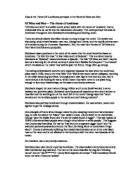They are obviously a rich family. They own a car, which would have been very expensive at the time and are all dressed in expensive looking furs.
The subjective camera is technique is used, from the point of view of one of the passengers in the car. This helps the audience to feel more connected with the film, as it almost like they are there with the characters.
This scene ends with the edges of the picture blacking out into a circle on the car as it drives past a big, dead tree. This seems to suggest that this phase of their lives is over, as the circle closes in on them. The inclusion of the dead tree seems to suggest what is to come in the next scene, at the funeral of Wilbur Minafer.
The second scene – the funeral scene - starts with a shot of the front door of the house with a wreath on. Combined with the cheery atmosphere and snow of the last scene, this could have the connotation of Christmas. However, non-diagetic, sombre sounding music starts to play and shows that it is actually a funeral. The door is opened by a black servant in a bowler hat. This suggests wealth. He lets in Lucy and Eugene, and shuts the door. His shadow can be seen on the glass window of the door.
The next shot is inside the house. It is a subjective shot from the point of view of Wilbur (who is dead). The low angle of the shot makes all the mourners seem superior to Wilbur, as though he was above them in life and this is the only way they can be better than him.
The only person who shows any emotion in this scene is Aunt Fanny. There is an extreme close-up on her face, which shows the emotion. Her face is partly in shadow, which suggests she’s hiding something, or trying not to show her true feelings.
There is diagonal criss-crossing on the ceiling. This is a large room, with a high ceiling and it should feel bright. The markings on the ceiling instead make it feel enclosed.
This part of the scene is in silence. This adds to the sombre feel of the scene and the funereal atmosphere.
There is then a two shot of two men having a conversation about how Wilbur will not be missed. This moves the narrative along as well as emphasising the fact that none of the people showed any emotion while viewing the body.
The third scene we watched was the Kitchen scene. This starts with an establishing shot of the house, with a storm raging over it. This suggests that something in the atmosphere of the scene is not settled. The house is large, showing again that the family are rich.
There is a lot of vertical framing used in this scene. There are bars in the kitchen window, suggesting that Aunt Fanny feels trapped, and the vertical racks of saucepans at the back of the shot suggest that she feels entrapped by her domestic surroundings.
Aunt Fanny and George sit quite separately. They never make eye contact, suggesting the metaphorical gap between them.
The lighting is all on George, whereas Aunt Fanny sits slightly behind him, in his shadow, once again suggestive of George’s selfish personality. After Fanny slams the door, the lighting on George is less, and the Uncle is lit up.
The sounds in this scene are largely non-diagetic weather sounds. Up until Fanny leaves the room, thunder and lightning can be heard; after she leaves it is just the sound of the rain, suggesting that the storm is a metaphor for Aunt Fanny’s state of mind. The thunder is heard especially in the gaps between speeches.
The conversation between Aunt Fanny and George is a long shot, which makes it seem more real. It is a two shot which allows us to see both of their reactions and means that there is no need for camera movement. After Fanny runs out, the camera pans to the left and follows George over to the window.







